Input interpretation

4, 4'-ethylenedipiperidine dihydrochloride
Basic properties
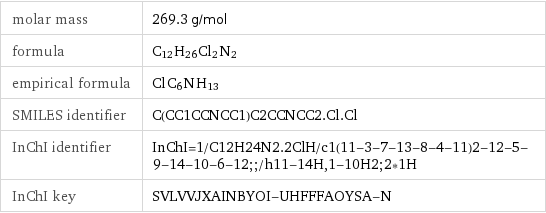
molar mass | 269.3 g/mol formula | C_12H_26Cl_2N_2 empirical formula | Cl_C_6N_H_13 SMILES identifier | C(CC1CCNCC1)C2CCNCC2.Cl.Cl InChI identifier | InChI=1/C12H24N2.2ClH/c1(11-3-7-13-8-4-11)2-12-5-9-14-10-6-12;;/h11-14H, 1-10H2;2*1H InChI key | SVLVVJXAINBYOI-UHFFFAOYSA-N
Structure diagram
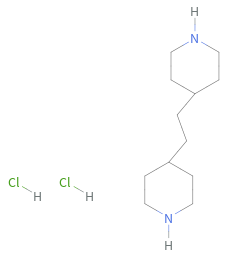
Structure diagram
Quantitative molecular descriptors
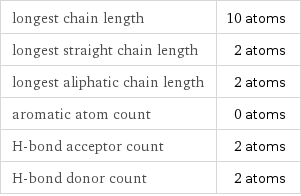
longest chain length | 10 atoms longest straight chain length | 2 atoms longest aliphatic chain length | 2 atoms aromatic atom count | 0 atoms H-bond acceptor count | 2 atoms H-bond donor count | 2 atoms
Elemental composition

Find the elemental composition for 4, 4'-ethylenedipiperidine dihydrochloride in terms of the atom and mass percents: atom percent = N_i/N_atoms × 100% mass percent = (N_im_i)/m × 100% Plan: • Write the chemical formula and gather atomic masses from the periodic table. • Determine values for N_i, m_i, N_atoms and m using these items. • Finally, compute the percents and check the results. Write the chemical formula: C_12H_26Cl_2N_2 Use the chemical formula to count the number of atoms, N_i, for each element and find the total number of atoms, N_atoms, per molecule: | number of atoms Cl (chlorine) | 2 C (carbon) | 12 N (nitrogen) | 2 H (hydrogen) | 26 N_atoms = 2 + 12 + 2 + 26 = 42 Divide each N_i by N_atoms to calculate atom fractions. Then use the property that atom fractions must sum to one to check the work: | number of atoms | atom fraction Cl (chlorine) | 2 | 2/42 C (carbon) | 12 | 12/42 N (nitrogen) | 2 | 2/42 H (hydrogen) | 26 | 26/42 Check: 2/42 + 12/42 + 2/42 + 26/42 = 1 Compute atom percents using the atom fractions: | number of atoms | atom percent Cl (chlorine) | 2 | 2/42 × 100% = 4.76% C (carbon) | 12 | 12/42 × 100% = 28.6% N (nitrogen) | 2 | 2/42 × 100% = 4.76% H (hydrogen) | 26 | 26/42 × 100% = 61.9% Look up the atomic mass, m_i, in unified atomic mass units, u, for each element in the periodic table: | number of atoms | atom percent | atomic mass/u Cl (chlorine) | 2 | 4.76% | 35.45 C (carbon) | 12 | 28.6% | 12.011 N (nitrogen) | 2 | 4.76% | 14.007 H (hydrogen) | 26 | 61.9% | 1.008 Multiply N_i by m_i to compute the mass for each element. Then sum those values to compute the molecular mass, m: | number of atoms | atom percent | atomic mass/u | mass/u Cl (chlorine) | 2 | 4.76% | 35.45 | 2 × 35.45 = 70.90 C (carbon) | 12 | 28.6% | 12.011 | 12 × 12.011 = 144.132 N (nitrogen) | 2 | 4.76% | 14.007 | 2 × 14.007 = 28.014 H (hydrogen) | 26 | 61.9% | 1.008 | 26 × 1.008 = 26.208 m = 70.90 u + 144.132 u + 28.014 u + 26.208 u = 269.254 u Divide the mass for each element by m to calculate mass fractions. Then use the property that mass fractions must sum to one to check the work: | number of atoms | atom percent | mass fraction Cl (chlorine) | 2 | 4.76% | 70.90/269.254 C (carbon) | 12 | 28.6% | 144.132/269.254 N (nitrogen) | 2 | 4.76% | 28.014/269.254 H (hydrogen) | 26 | 61.9% | 26.208/269.254 Check: 70.90/269.254 + 144.132/269.254 + 28.014/269.254 + 26.208/269.254 = 1 Compute mass percents using the mass fractions: Answer: | | | number of atoms | atom percent | mass percent Cl (chlorine) | 2 | 4.76% | 70.90/269.254 × 100% = 26.33% C (carbon) | 12 | 28.6% | 144.132/269.254 × 100% = 53.53% N (nitrogen) | 2 | 4.76% | 28.014/269.254 × 100% = 10.40% H (hydrogen) | 26 | 61.9% | 26.208/269.254 × 100% = 9.734%
Elemental oxidation states

The first step in finding the oxidation states (or oxidation numbers) in 4, 4'-ethylenedipiperidine dihydrochloride is to draw the structure diagram. Next set every oxidation number equal to the atom's formal charge: In 4, 4'-ethylenedipiperidine dihydrochloride hydrogen is not bonded to a metal with lower electronegativity, so it will have an oxidation state of +1. Any element bonded to hydrogen gains the bonding electrons, decreasing their oxidation state by 1 for every bond: With hydrogen out of the way, look at the remaining bonds. There are 4 carbon-nitrogen bonds, and 11 carbon-carbon bonds. For each of these bonds, assign the bonding electrons to the most electronegative element. First examine the carbon-nitrogen bonds: element | electronegativity (Pauling scale) | C | 2.55 | N | 3.04 | | | Since nitrogen is more electronegative than carbon, the electrons in these bonds will go to nitrogen. Decrease the oxidation number for nitrogen in every highlighted bond (by 1 for single bonds, 2 for double bonds, and 3 for triple bonds), and increase the oxidation number for carbon accordingly: Next look at the carbon-carbon bonds: element | electronegativity (Pauling scale) | C | 2.55 | C | 2.55 | | | Since these elements are the same the bonding electrons are shared equally, and there is no change to the oxidation states: Now summarize the results: Answer: | | oxidation state | element | count -3 | N (nitrogen) | 2 -2 | C (carbon) | 6 -1 | C (carbon) | 6 | Cl (chlorine) | 2 +1 | H (hydrogen) | 26
Orbital hybridization
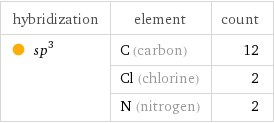
hybridization | element | count sp^3 | C (carbon) | 12 | Cl (chlorine) | 2 | N (nitrogen) | 2
Structure diagram
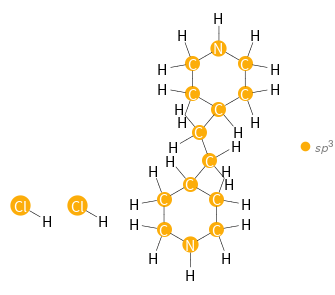
Orbital hybridization Structure diagram
Topological indices
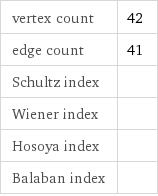
vertex count | 42 edge count | 41 Schultz index | Wiener index | Hosoya index | Balaban index |